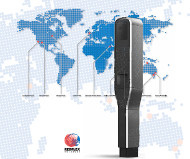Article from: www.thenewspaper.com/news/42/4253.asp
11/7/2013
Red Light Cameras Losing Ground Nationwide
Redflex warns of contagion effect of bribery scandal reducing traffic camera installations.
 Setbacks in the automated enforcement industry have have reached the point where the total number of red light camera and speed camera installations in the United States is on the decline. Redflex Traffic Systems, the second largest provider of automated ticketing machines in America, reported the first ever drop in the number of automated ticketing machines since it entered the market. For more than a dozen years, the Australian firm has enjoyed an unbroken streak, adding cameras year after year, despite the recession and turmoil in the financial markets. The streak came to an abrupt end in 2013, largely due to the bribery scandal in Chicago, Illinois and at least two other cities.
Setbacks in the automated enforcement industry have have reached the point where the total number of red light camera and speed camera installations in the United States is on the decline. Redflex Traffic Systems, the second largest provider of automated ticketing machines in America, reported the first ever drop in the number of automated ticketing machines since it entered the market. For more than a dozen years, the Australian firm has enjoyed an unbroken streak, adding cameras year after year, despite the recession and turmoil in the financial markets. The streak came to an abrupt end in 2013, largely due to the bribery scandal in Chicago, Illinois and at least two other cities.
"The potential contagion effect of our internal investigative disclosures may impact our ability to continue to retain existing customers and win new contracts," the firm admitted in its 2013 annual report.
In 2002, Redflex had 101 cameras active in the United States, and the figure nearly doubled to 180 the following year. By 2005, it grew to 489. In 2008, it hit 1267. By 2012, the number of installations peaked at 2010 -- a 59 percent jump. This year, the number slid to 1987, and TheNewspaper estimates 2014 will begin with just 1603 active cameras, a 25 percent plunge from the peak, as the Chicago cameras go offline.
These stark numbers will hit the company's bottom line hard. Net profit after tax for the firm plunged from $15.1 million to $7.3 million in 2013. The firm described all profit measures as "below target."
Despite the lackluster performance, replacement CEO Robert DeVincenzi pocketed a $589,134 bonus on top of a $438,212 salary, a $339,428 completion bonus and a $27,373 consulting fee. DeVincenzi took over in the wake of senior management departures sparked by the bribery scandal. The casualties included board chairman Max Findlay, director Ian Davis, CEO Graham Davie, head of US operations Karen Finley, general counsel Andrejs Bunse, executive vice president Aaron Rosenberg and chief financial officer Sean Nolen.
To fight back against the mounting losses, the company continues to hire public relations firms that pose as local "traffic safety advocates" to create the image of widespread support for red light camera and speed camera installation.
"The company maintains an active communications and legislative affairs program to minimize the risks associated with adverse legislation," the annual report explained. "The program is focused on developing local traffic safety advocacy groups, developing political support at a local, state or provincial level and communicating the safety and efficacy of automated traffic enforcement systems to the public."
 Setbacks in the automated enforcement industry have have reached the point where the total number of red light camera and speed camera installations in the United States is on the decline. Redflex Traffic Systems, the second largest provider of automated ticketing machines in America, reported the first ever drop in the number of automated ticketing machines since it entered the market. For more than a dozen years, the Australian firm has enjoyed an unbroken streak, adding cameras year after year, despite the recession and turmoil in the financial markets. The streak came to an abrupt end in 2013, largely due to the bribery scandal in Chicago, Illinois and at least two other cities.
Setbacks in the automated enforcement industry have have reached the point where the total number of red light camera and speed camera installations in the United States is on the decline. Redflex Traffic Systems, the second largest provider of automated ticketing machines in America, reported the first ever drop in the number of automated ticketing machines since it entered the market. For more than a dozen years, the Australian firm has enjoyed an unbroken streak, adding cameras year after year, despite the recession and turmoil in the financial markets. The streak came to an abrupt end in 2013, largely due to the bribery scandal in Chicago, Illinois and at least two other cities.